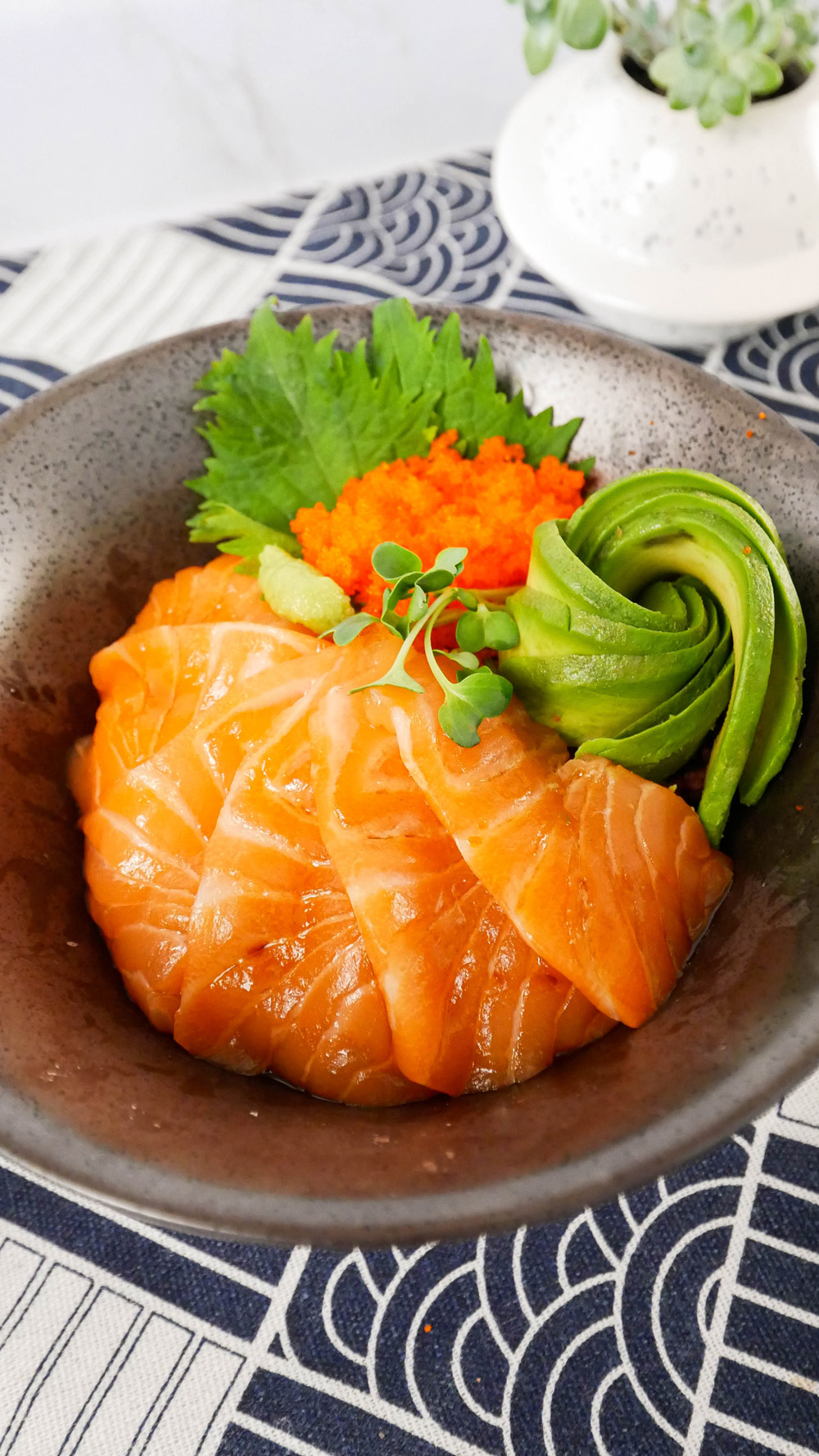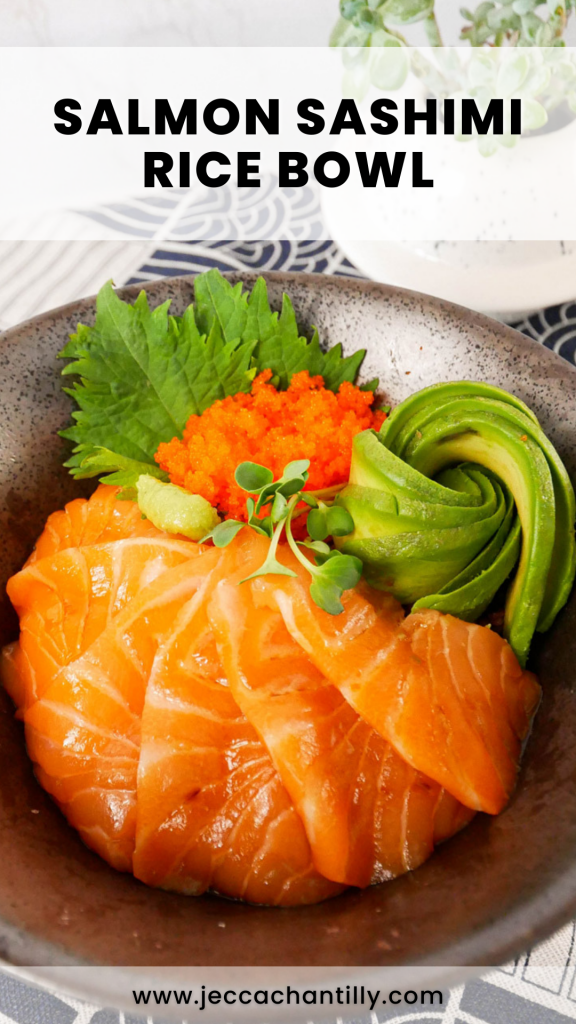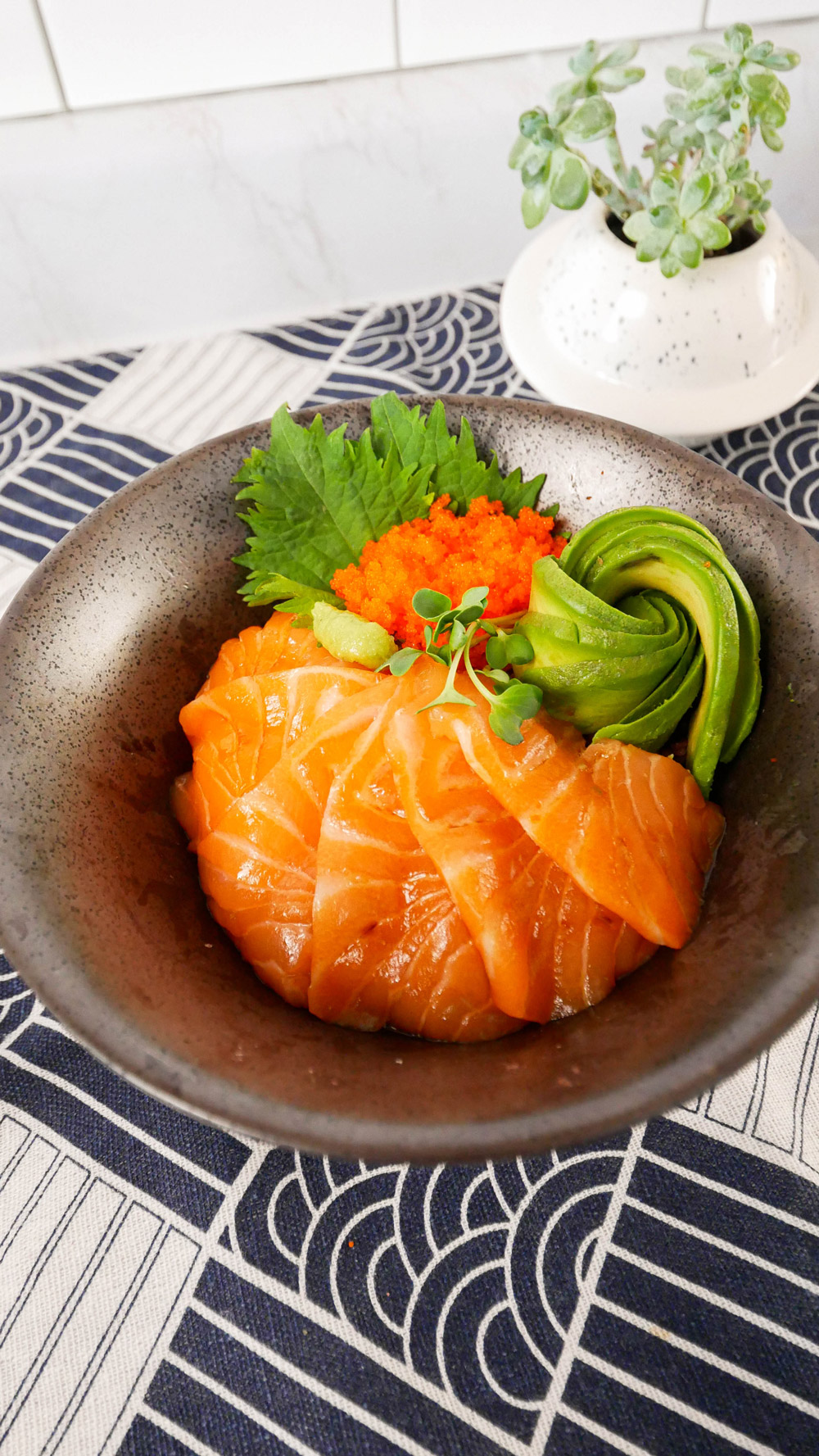If you want to learn how to make a restaurant-quality salmon sashimi rice bowl without the restaurant price tag, this recipe is for you! This salmon sashimi donburi or rice bowl is one of my favorite quick and easy meals to prepare at home. You only need 10 minutes and a few simple ingredients to create a delicious, healthy, and affordable lunch or dinner.
With that being said, it’s very important to use the freshest ingredients when making this recipe to highlight the natural flavors of the ingredients. I highly recommend purchasing the sashimi-grade salmon from a reliable source – it’s the star of this dish so you need to let it shine!
Why you’ll love this recipe
You no longer have to trek to your favorite sushi place or order takeout when you can easily make your own version of this salmon sashimi rice bowl at home, and even better. As long as you have fresh sushi-grade salmon, the rest of the ingredients are easily accessible or may already be in your pantry!
This rice bowl is made of freshly cooked rice topped with sliced sashimi salmon and served with a flavorful umami-rich mentsuyu sauce. The mentsuyu sauce is a combination of sweet, salty, and umami which enhances the flavors of the salmon and rice. I made my 5-minute homemade version of mentsuyu for this recipe however you can also purchase a bottle of mentsuyu to save some time.
To complete the rice bowl, it is garnished with sliced avocados (extra brownie points if you shape it into a rose), shiso leaves, a generous dollop of fish roe and a dab of wasabi. I love the addition of avocado and fish roe because they add a creamy and salty element that complements the delicateness of the sashimi. While this is just my personal preference, feel free to garnish your rice bowl with the ingredients that you desire!
How do I prepare Salmon Sashimi Rice Bowl?
Since there is no cooking involved to prepare this bowl (aside from the rice and mentsuyu sauce), this really is a low-effort meal that can be prepared any time of the day. To get started, follow the instructions below:
Step 1: Prepare the mentsuyu sauce.
In a pot, combine soy sauce, mirin, sake, and kelp and bring to a boil over medium heat. Once the mixture comes to a boil, add the bonito flakes and simmer on low for 3 to 5 minutes. Next, strain and let the sauce cool in the fridge.
Step 2: Prepare the rice.
Scoop the rice into a bowl and shape it into a round dome shape. Let it cool down to room temperature.
Step 3: Slice the salmon.
Next, grab the fresh salmon and slice it into ¼-inch thick pieces. I prefer to cut them at an angle so they look better for presentation however this is optional. If you’d like to know how I do it, you can also watch the video below!
Step 4: Slice the avocado.
Cut the avocado in half then carefully peel the skin away. Lay the peeled avocado cut side down. Using the tip of a sharp knife, make thin slices from top to bottom. The slices should be thin so it’s easier to shape later.
To make an avocado rose, fan out the sliced avocado with your hands to spread it out into a long line, about 8 to 12 inches long. Be sure to spread out the slices evenly. Once spread out, take one end of the avocado and curl it towards the center. Keep curling until a rose forms. For a guided video on how to make an avocado rose, check out my video HERE!
Step 5: Assemble the rice bowl.
Once the rice has slightly cooled, drizzle 1 teaspoon of the mentsuyu sauce on top. Next, arrange the sliced salmon on top of the rice by arranging it around the dome. For better presentation, you can slightly overlap the salmon to cover the rice completely. Finally, top with avocado, shiso leaf, fish roe, and wasabi over the salmon. Drizzle another teaspoon of mentsuyu sauce over the salmon and serve immediately. Enjoy!
Cooking tips for Salmon Sashimi Rice Bowl
The steps in this recipe are pretty simple and straightforward, but here are a few tips you can keep in mind to make the best version of this dish every time!
- If you’re making fresh rice for this dish, make sure to allow it to cool down to room temperature before placing it on the salmon to avoid cooking it. If you lay the sashimi salmon on hot steamy rice, it will cook the salmon!
- For leftover mentsuyu sauce, you can store it in an airtight container in the fridge and it will for up to 4 weeks. Mentsuyu sauce is great to season rice, noodles, and even salads! If you’re in a bind and can’t make the mentsuyu sauce, you can also purchase a bottle at your local Japanese market or on Amazon.
- The shiso leaf (or perilla) is very a pungent and aromatic herb. It has bright, citrusy undertones that also resemble mint and basil. This herb is an optional garnish so don’t sweat it if you can’t find any or you don’t like the taste of shiso leaves.
- Feel free to substitute the salmon for any other sashimi-grade fish such as tuna, amberjack, fluke, yellowtail, or red snapper.
Salmon Rice Bowl Ingredients & Substitutions
Salmon (sashimi grade): since this recipe calls for minimal ingredients, I highly recommend using the highest quality and freshest salmon you can find. Aside from salmon, you can also use other sashimi-grade fish, like tuna, amberjack, fluke, yellowtail, or red snapper.
Short-grain rice: the best type of rice to use for this rice bowl is short-grain rice (or sushi rice) due to its high starch content and sticky consistency. You could substitute it with medium-grain rice but I don’t recommend using long-grain rice for this recipe.
Avocado: avocados add creaminess to the rice bowl and helps tie all the ingredients together. You could substitute the avocado for edamame or cucumber, or omit it if you prefer.
Fish roe: the fish roe is like small beads that pop when you bite into them so it adds a nice texture to balance the delicateness of the salmon and the creaminess of the avocado. It also adds another layer of flavor and umami to the rice bowl. You can use any type of fish roe including masago (capelin fish), tobiko (flying fish roe), ikura (salmon roe), and even caviar (sturgeon roe)!
Shiso leaf: aside from adding to the presentation, a shiso leaf can also brighten up the flavors of the rice bowl. You can substitute shiso leaf with basil, mint leaves, or nori sheets (roasted seaweed).
Wasabi: This spicy condiment helps to balance out the fattiness of the salmon while enhancing the flavor of the raw fish. Too much wasabi can overpower the entire dish so start with a conservative amount and adjust if needed. You can either use pre-made wasabi or fresh wasabi root. If you don’t like the taste of wasabi, you can omit it from the rice bowl.
Mentsuyu Ingredients & Substitutions
Soy sauce: the soy sauce is the foundation of the seasoning in the mentsuyu sauce. Feel free to use low-sodium soy sauce if you want to reduce the saltiness.
Mirin: the sugar content in mirin adds a subtle hint of sweetness to the sauce. To replace mirin, you can use mix 1 teaspoon of white wine vinegar or rice vinegar with ½ teaspoon of sugar for every 1 teaspoon of mirin.
Sake: a splash of sake adds a hint of sweet and fruity flavor to the mentsuyu sauce, but you can also substitute it with dry sherry, Chinese rice wine, or omit it completely.
Dried kelp (or kombu): the dried kelp adds a briny, savory flavor to the sauce. You can substitute it with soy sauce or more bonito flakes.
Bonito flakes: bonito flakes or ‘katsuobushi’ have a signature umami and seafood essence that enhances the flavors of this sauce. You can also substitute bonito flakes with dried shiitake mushrooms or more dried kelp.
Rice Bowl Topping Customizations
Aside from avocado slices and fish roe, here are a few other ingredients you can add to your rice bowl to make it more flavorful to enjoy:
1. Pickled ginger – if you’ve eaten sushi before, you’re probably familiar with this side dish. The pickled ginger will help cut through the fattiness of the salmon and the creaminess of the avocado.
2. Furikake – furikake is a seasoning with umami-rich flavors, so a sprinkle on top of this rice bowl will have you addicted!
3. Seaweed salad – seaweed salad or ‘wakame’ is traditionally served with sushi, so it’s no surprise that it will beautifully complement the salmon sashimi.
Frequently Asked Questions
How do you know if salmon is sushi-grade?
Sushi-grade salmon is a type of fish that’s deemed safe to eat uncooked. Sushi-grade salmon should be flash-frozen at -21°F (-29°C) immediately after being caught or within 30 to 48 hours. Since you’ll be using raw salmon for this recipe, mishandled fish may carry parasites or bacteria that can make you sick. With that being said, it’s very important to purchase salmon that is actually sushi-grade from a reliable source. I like to buy my fish from my local Japanese market or fish market.
You’ll know the salmon is fresh when it has a vibrant orange hue and can solidly hold its shape. Remember to steer clear of any salmon that has a milky white substance on the surface or an off-smell.
What is mentsuyu sauce?
Mentsuyu sauce is a concentrated noodle soup base that’s used for flavoring ramen, udon, or soba noodles. When diluted, it can also be used as a dipping sauce for fried foods, like tempura. The dried kelp and bonito flakes build the umami taste of the sauce, while the sake and mirin round out the flavors by adding a touch of sweetness.
I prefer to use mentsuyu sauce for this rice bowl recipe because it’s lighter and won’t overshadow the flavors of the salmon sashimi. There are ready-made mentsuyu sauces available in the market, but making it at home allows you to adjust the saltiness and flavors of the sauce.
What are bonito flakes made of?
Bonito flakes or ‘katsuobushi’ in Japanese, are thin flakes that are made from smoked, fermented, and dried bonito fish or skipjack tuna. It’s a staple in Japanese cuisine, and it’s usually used for flavoring dashi stock, sauces, stir-fries, or as filling for onigiri. To make bonito flakes, they filet the fish then simmer and smoke it for a month before sun-drying. A mold, called aspergillus glaucus, is then applied to the fish to promote fermentation. Once the drying process is complete, the fish are then shaved into thin pieces.
Can you store Salmon Sashimi Rice Bowl?
I don’t recommend storing any leftovers in the fridge because the salmon is raw. This dish should be consumed within 24 hours otherwise, you’ll risk the fish spoiling after 1 to 2 days. If you have a big batch of raw salmon, portion them out into manageable pieces then store them in the freezer. When you’re ready to eat the salmon, just take it out and thaw what you need.
Looking for more easy and delicious salmon recipes? Check out these recipes below!
1. Pan Seared Miso Salmon – if you’re looking for a quick one-pan meal, you’ll love this juicy salmon recipe that’s drizzled with an exquisitely sweet and umami mushroom and miso glaze.
2. Spicy Salmon Poke Bowl – for a spicy take on this rice bowl, I recommend giving this tasty salmon poke bowl a try. It’s packed with a sweet, spicy, and tangy sauce that elevates the flavor of the poke bowl.
3. Japanese Salted Salmon (Shiozake) – this recipe proves that you don’t need to add a lot of ingredients to make the flavors of fresh salmon shine. As long as you have salt and sake, you can enjoy this classic Japanese-inspired dish!
4. Salted Salmon Onigiri – if you love shiozake (salted salmon), try filling it in an onigiri! Similar to the original dish, it contains simple and fuss-free ingredients that put the salmon in the spotlight.
5. Pan Seared Salmon with Crispy Skin – if you love crispy salmon skin as much as I do, you’ll want to try my pan-seared salmon recipe. It’s served with a creamy avocado crema and a refreshing spicy frisée salad that you’ll be thinking about for days!
Here are some of my favorite Japanese-inspired recipes!
- Pork Katsudon
- Miso Marinated Cod
- Steak Donburi
- Mentaiko Pasta
- Mushroom Rice Bowl
- Carrot Ginger Miso Salad Dressing

Salmon Sashimi Rice Bowl
Ingredients
- 8 oz salmon sashimi grade
- 2 cups cooked rice short-grain rice or sushi rice
- 1 avocado sliced
- 4 tbsp fish roe
- 2 shiso leaf for garnish, optional
- wasabi to taste
Mentsuyu Sauce
- 1/2 cup soy sauce
- 1/4 cup mirin
- 1/4 cup sake
- 3 dried kelp
- 1/4 cup bonito flakes
Instructions
- In a pot, combine soy sauce, mirin, sake, and kelp and bring to a boil over medium heat. Once boiling, reduce to a simmer then add the bonito flakes. Simmer on low for 3 to 5 minutes. Strain and cool in the fridge.
- Scoop the rice into a bowl and shape it into a round dome shape. Set this aside for a few minutes to allow the rice to come to room temperature.
- While the rice is cooling, slice the salmon into 1/4-inch thick pieces, preferably at an angle for better presentation.
- Once the rice has cooled, add 1 teaspoon of the mentsuyu sauce from earlier over the rice.
- Top the rice with sliced salmon, by arranging it around the dome. For better presentation, you can slightly overlap the salmon to cover the rice completely.
- Top with sliced avocado, shiso leaf, fish roe, and wasabi,
- Drizzle another teaspoon of the mentsuyu sauce over the salmon. Add more if needed.
- Serve immediately!
Notes
2. You can purchase bottled mentsuyu sauce at a Japanese market.
3. The homemade mentsuyu sauce will last in the fridge for up to 4 weeks!
Pin & save this recipe for later!

